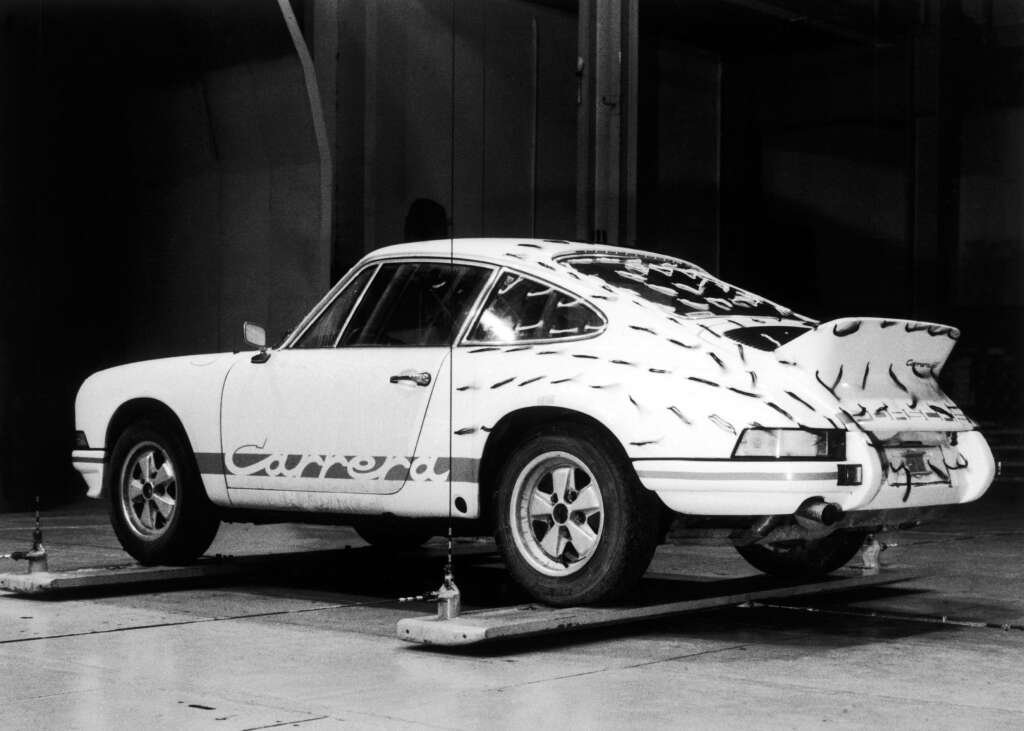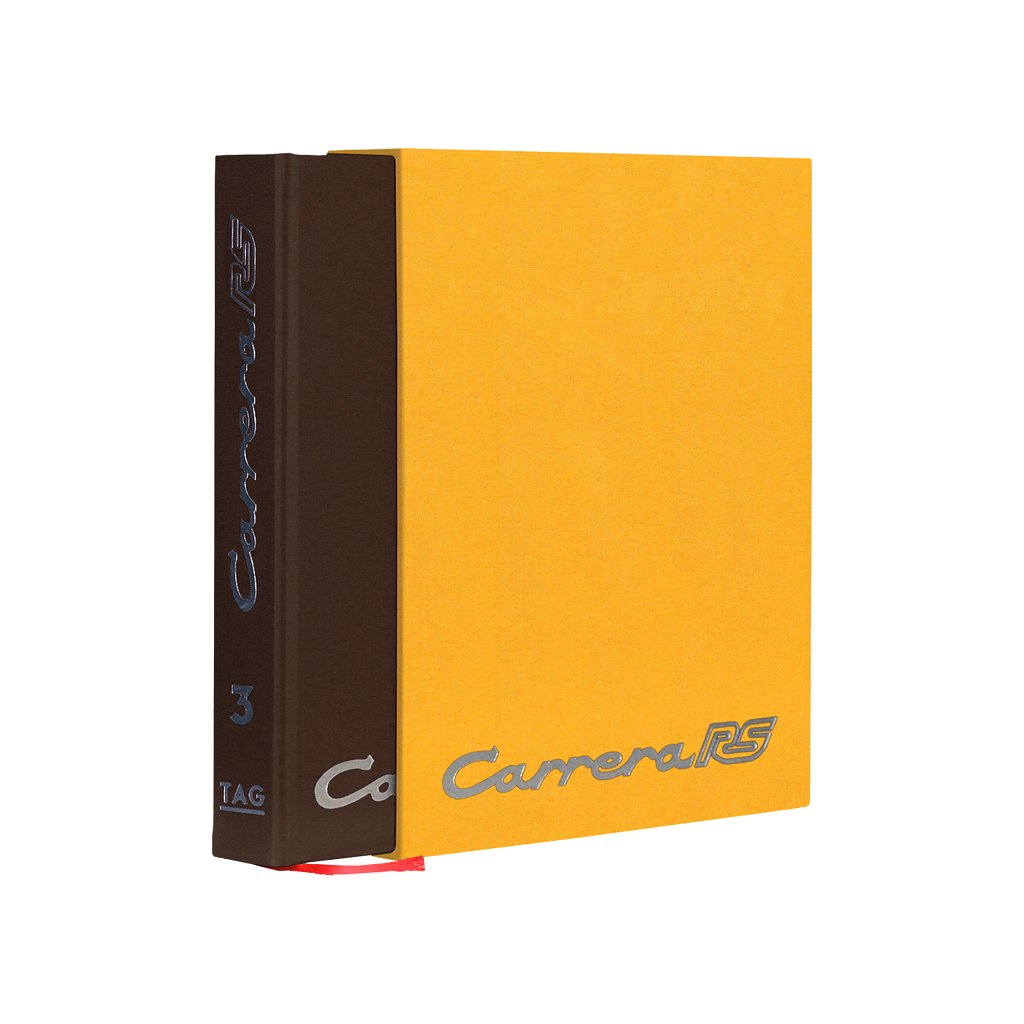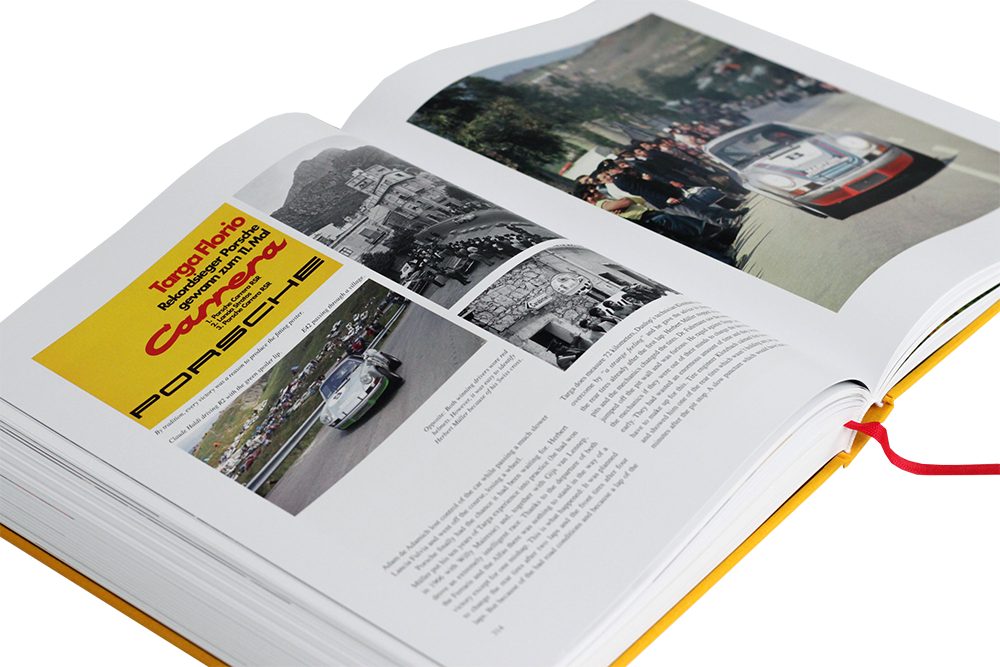For half a century, the German word Rennsport, which means motorsport or racing, has been inextricably linked with Porsche. With the introduction of the Porsche 911 Carrera RS 2.7 in 1972, it became synonymous worldwide with Porsche homologation vehicles. For many, the 911-based RS models are still considered the holy grail of the Porsche world. We celebrate the Porsche 911 Carrera RS 2.7’s 50th anniversairy and take a look at the history of one of the sharpest naturally aspirated sports cars from Zuffenhausen.
50 years of Porsche 911 Carrera RS 2.7 – „Germany’s fastest sports car“
Peter Falk, then head of testing for production vehicles at Porsche, describes the development goals for the Porsche 911 Carrera RS 2.7 as follows: “The 911 Carrera RS 2.7 was intended as a homologation vehicle. It was to be a very light, fast sports car.” This objective was exceeded by the development team, which included legends such as Valentin Schäffer and Hans Mezger with ease. 210 hp at a kerb weight of 960 kg in the RS Sport version made the 911 Carrera RS 2.7 Germany’s fastest sports car. It accelerated from 0 to 100 kph in 5.8 seconds – unimaginable for a production car of that time! The thrust only ended at over 245 kph.

After the presentation on 05 October 1972 at the Paris Motor Show, Porsche was overrun with orders. By the end of November, the entire planned production of 500 units had been sold out. By July 1973, Porsche had sold a total of 1,580 Porsche 911 Carrera RS 2.7 cars, divided into 200 cars in the lightweight “Sport” version (equipment code M471), 55 racing cars, 17 base cars and 1,308 RS Touring (M472).
The 911 Carrera RS 2.7’s ducktail initiated a spoiler boom!
Externally, the Porsche 911 Carrera RS 2.7 stood out clearly from the other F-models. This was primarily due to the front and rear spoilers. Both were the result of purely technical necessity. The first racing 911 had too much lift – especially on the rear axle. The focus was therefore on aerodynamic improvements. However, the developments were not intended to distort the character of the 911. After three days in the wind tunnel, Hermann Burst’s team had the solution: the ducktail!
And it was precisely the results of this test that surprised the engineers. Their new finding: the “ducktail” uses its elevation to push the 911 Carrera RS 2.7 toward the road when the car is moving fast and supplies the rear engine with additional cooling air. And that effect is achieved without any increase in drag – on the contrary. With the rear spoiler, the RS achieved a 4.5 km/h faster top speed.

Porsche set a real trend with the homologation of the front and rear spoilers. This was because the Porsche 911 Carrera RS 2.7 was the first production car with a rear spoiler as standard. (Incidentally, the spoilers were initially planned as optional extras). Since then, rear spoilers have been standard on almost all sports cars. “For me at the time, the spoiler was just a solution to a technical problem. I didn’t realize for a long time that we had created an icon with it,” recalls co-inventor Hermann Burst.
The RS was the first Porsche 911 to be given the epithet Carrera
The sharpest Porsche 356s with four-camshaft/Fuhrmann engines were called “Carrera” back then – Spanish for race. This nomenclature originated with the Carrera Panamericana. Porsche took the first class victory in the company’s history in an endurance race here in 1952 with a 550 Spyder. This was followed in 1954 by the first podium with a third place overall in a 550 Spyder.
After the 356 was replaced by the 911, no Porsche was called Carrera anymore. With the RS, the name was to be reactivated. A certain Harm Lagaay was responsible for the design and positioning of the lettering at the time. The position between the wheels was agreed upon quite quickly. The first drafts still envisaged lettering in a contrasting color on the sill with slight shading. “With a dark paint job, however, the name would have been very difficult to read,” explains the former Porsche designer.
The team then drew up the blueprint for the next few decades. Now the Carrera lettering is framed in a contrasting color to the body paint, crossed by a wide stripe in the same color. “Since the 911 Carrera RS 2.7 was mostly sold only in light paint colors, the lettering is very easy to read,” says Harm Lagaay.
Carrera RS based race cars were succesful almost everywhere
In a Porsche 911 Carrera RSR, Peter Gregg and Hurley Haywood won the 24 Hours of Daytona outright in February 1973. They crossed the finish line with a whopping 22 laps to spare. At the subsequent 12 Hours of Sebring, the duo, supported by Dr. Dave Helmick, won again. The Porsche 911 Carrera RSR was also victorious at the Targa Florio. At Le Mans, the Martini and Toblerone-Porsche claimed P4 and 5 overall. The Porsche 911 Carrera RS even took second place in the 1974 East African Rally.
His repertoire: By axle to the race and home again. Monday to the office. Tuesday to Geneva. Back in the evening. Wednesday to shopping. City. Traffic jam. Creeping traffic, but no plug sooted, no clutch on strike. Thursday country road, highway, serpentines, dirt roads, construction sites, Friday only short distance and cold starts again and again. Saturday with vacation luggage to Finland. Carrera RS – full of inexhaustible reserves in both sprints and marathons.
Porsches ad for the 911 Carrera RS 2.7
From today’s perspective, the Porsche 911 Carrera RS 2.7 formed the foundation of customer motor racing on a 911 basis. Many customer teams bought Porsche 911 Carrera RS and RSR for racing. The Zuffenhausen race cars were competitive ex works, often even capable of winning. Coupled with outstanding reliability and spare parts supply, Porsche earned a reputation at this time that still sticks with the 911 today. For decades, no manufacturer offered a comparable package for customer motorsport.
“The most direct technology transfer from motorsport to series production there is”
Andreas Preuninger, head of Porsche GT vehicles, drew inspiration from the Carrera RS for his first own project – the Porsche 996 GT3 RS. “It is the most direct technology transfer from motorsport to series production there is. That hasn’t changed to this day and is part of Porsche’s living tradition,” says Preuninger. “An RS model from Porsche is characterized by the most emotional connection between road and racing. It is the unfiltered driving experience that Porsche has stood for for 50 years,” he says, summing up the mantra of Porsche Rennsport models.
After the RS on F-model basis, there was no racing Carrera within the G-model era. The abbreviation was not revived until the Porsche 964 Carrera RS. After the subsequent 993 Carrera RS, the Carrera RS came to an end. Thus there was only a trio of Carrera RS. However, the RS abbreviation itself was retained. It is reserved exclusively for GT vehicles. Since the 996, it has adorned the most purist Porsche 911 GT3, and since the 997, Porsche 911 GT2 models as well. The Carrera RS name is thus true legend material-for 50 years.
Porsche 911 Carrera RS – Offers, prices, value
A car as rare and sought-after as the RS is not easy to classify in terms of supply and value development. One thing in advance: The high prices, which are quite rightly paid for these cars, attract counterfeiters! Many of these cars are sold through contacts, but even so, over 50 examples have already been offered on Elferspot. The prices called for decent Rennsport 911s have been consistently above half a million USD since 2022. Below that, it will probably be difficult to get a good RS with a traceable history.
There have already been a few outliers that have achieved seven-figure prices. In most cases, however, these were exceptionally well-preserved vehicles with special equipment M471, i.e. the sports version. In addition, there were often prominent previous owners or particularly interesting historical details. Whoever is interested in a genuine RS needs patience on the one hand and must act very quickly if a good car comes up. The gold-rush atmosphere, which in some cases has seen an annual increase in value of several hundred thousand USD, is certainly over, but demand still exceeds supply.
© header: Porsche AG
Elferspot magazine
You have reached your article limit for this month.
Become an Elferspot Member now and get unlimited access to our Elferspot Magazine and other features!
- No obligations or charges.
- We help you find your dream car: get newly added cars straight into your mailbox.
- Your own watch list for your favorite cars.
- Unlimited access to Elferspot Magazin.
- -10% welcome discount for Elferspot textile products
- Successfully sell your Porsche via Elferspot.










